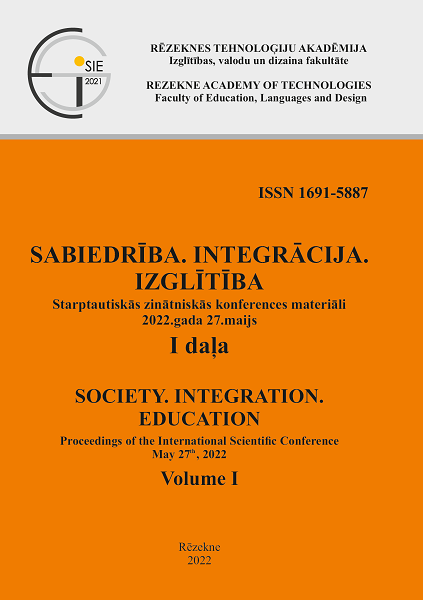SEXUALITY EDUCATION TO PREVENT INTIMATE PARTNER VIOLENCE
DOI:
https://doi.org/10.17770/sie2022vol1.6871Keywords:
comprehensive sexuality education, intimate partner violence, preventionAbstract
The “discovery” of intimate partner violence in the 1970s by the feminist movement, which considered it to be a private affair between two people, showed that the phenomenon is a recurrent one, occurring in a wide range of romantic relationships, whether committed, dating, or casual, and both current and former, across races, social classes, ages, adults and adolescents. Research has shown that existing criminal justice, health and social interventions do not address intimate partner violence. Changing culturally constructed attitudes that make men dominant and controlling, women dependent and invisible, and the use of gender-sensitive policies are key to addressing violence against women. It is argued that comprehensive sexuality education, as a preventive measure that introduces an appreciation of personal needs in terms of the well-being of the other person and of society, can help to address intimate partner violence. The aim of this article is to show the importance of a sexuality education perspective in the prevention of intimate partner violence against women. The study shows that in order to prevent intimate partner violence against women and girls, it is important to develop the ability to recognise violence related to unequal power in relationships, to be able to name types of violence, and to be able to identify symptoms of violent behaviour. The research design used was qualitative research, semi-structured interviews to collect data, and the participants were women who had experienced violence in intimate relationships.References
Bitinas, B. (2013). Rinktiniai edukologinai raštai. 2 T. Vilnius: Edukologija.
Blum, R. W., Mmari, K., & Moreau, C. (2017). It begins at 10: How gender expectations shape early adolescence around the world. Journal of Adolescent Health, 61(4), S3–S4.
Cavanagh, K. (2003). Understanding Women's Responses to Domestic Violence. Qualitative Social Work, 2(3), 229-249.
Council of Europe. (2007). Convention on the Protection of Children against Sexual Exploitation and Sexual Abuse. Retrieved from https://e-seimas.lrs.lt/portal/legalAct/lt/TAD/TAIS.434001
DeKeseredy, W.S., & Schwartz, M.D. (2011). Theoretical and Definitional Issues in Violence against Women. Violence Against Women. DOI:10.4135/9781452224916_n1
Elshtain, J.B. (2002.) Vyro viešumas, moters privatumas. Vilnius: Pradai.
Ministry of Education and Science of the Republic of Lithuania. (2016). On the Approval of the General Programme for Health and Sexuality Education and Family Preparation. Retrieved from https://e-seimas.lrs.lt/portal/legalAct/lt/TAD/285853b09aee11e68adcda1bb2f432d1
Dobash, R.P. & Dobash, R.E. (1979). Violence against wives: A case against the patriarchy. New York, NY: Free Press.
Dodi, L. (2019). Educational Value of Johan Vincent Galtung’s Conflict Resolution in Reducing Gender Issues Based Violence. Didaktika Religia 6(2), 327-350.
Galtung, J. (1990). Cultural violence. Journal of Peace Research, 27(3), 291-305.
Giniotaitė, 2018. Lytiškumo ugdymas. Esamos ir galimos tapatybės. Nuo postmodernizmo posthumanizmo link. ACTA PAEDAGOGICA VILNENSIA, 155-168.
Gracia, E. & Herrero, J. (2006). Acceptability of Domestic Violence against Women in the European Union: A Multilevel Analysis. Journal of Epidemiology and Community Health, 60(2), 123–129.
Gutierrez, L.M. (1987). Social Work Theories and Practice with Battered Women: A Conflict-of-Values Analysis. Affilia, 2(2), 36-52.
Gustaitienė, M. (2005). Smurto prieš moteris priežastys ir prevencija. Sociologija. Mintis ir veiksmas, 1, 110-121.
Herman, J.L. (2006). Trauma ir išgijimas: prievartos pasekmės – nuo buitinio smurto iki politinio teroro. Vilnius: Vaga.
Holden, J., Bell, E. & Schauerhammer, V. (2015). We Want to Learn About Good Love: Findings from a Qualitative Study Assessing the Links Between Comprehensive Sexuality Education and Violence Against Women and Girls. London: Plan International UK and Social Development Direct. Retrieved from https://gsdrc.org/document-library/we-want-to-learn-about-good-love-findings-from-a-qualitative-study-assessing-the-links-between-comprehensive-sexuality-education-and-violence-against-women-and-girls/
Kimmel, M.S. (2000). The Gendered Society. New York: Oxford University Press.
Krug, E.G., Dahlberg, L.L., Mercy, J.A., Zwi, A.B., & Lozano, R. (2002). World report on violence and health. Retrieved from https://obtienearchivo.bcn.cl/ obtienearchivo?id=documentos/10221.1/56280/1/report_violence_health.pdf
Kyegombe, N., Starmann, E., Devries, K.M., Michau, L., Nakuti, J., Musuya, T., Watts, C., & Heise, L. (2014). „SASA! is the medicine that treats violence“. Qualitative findings on how a community mobilisation intervention to prevent violence against women created change in Kampala, Uganda. Global Health Action, Vol.7 – Issue 1. DOI: 10.3402/gha.v7.25082
Lietuvos Respublikos Seimas. (2011) Law on Protection against Domestic Violence of Lithuanian Republic. Retrieved from https://e-seimas.lrs.lt/portal/legalAct/lt/TAD/TAIS.410975
Lithuanian Department of Statistics. (2020). Domestic violence. Retrieved from https://osp.stat.gov.lt/infografikas-smurtas-artimoje-aplinkoje
Moulin-Stozek, M. (2021). Why should intimate partner violence prevention be integrated in sex education. Journal of Moral Education, 50(3), 317-329
Novelskaitė, A. (2012). Socialinio tyrimo terminija: tyrimo strategija, tyrimo planas, tyrimo dizainas, tyrimo procesas. Vilniaus universiteto Kauno humanitarinis fakultetas.
Purvaneckienė, G., Venslovaitė, V., Stonkuvienė, I. & Žiliukaitė, R. (2019). Smurtas artimoje aplinkoje: prevencija, apsauga, pagalba, bendradarbiavimas. Kokybinio Tyrimo Ataskaita. Retrieved from https://socmin.lrv.lt/uploads/socmin/documents/files/Ataskaita_Smurtas_artimoje_aplinkoje%20-%20kokybinio%20tyrimo%20ataskaita_docx%20(5).pdf
Pilinkaitė Sotirovič, V. & Vaigė, L. (2017). Challenges for preventing violence against women in Lithuania. Filosofija. Sociologija, 28(4), 268-276.
Troisi, G. (2018). Measuring Intimate Partner Violence and Traumatic Affect: Development of VITA, an Italian Scale. Frontiers in Psychology. DOI: https://doi.org/10.3389/fpsyg.2018.01282
United Nations. (1989). Convention on the Rights of the Child. Retrieved from https://www.unhcr.org/uk/4d9474b49.pdf
United Nations. (1924). Geneva Declaration of the Rights of the Child. Retrieved from http://www.un-documents.net/gdrc1924.htm
World Health Organization (2021). The Journey towards Comprehensive Sexuality Education Global Status Report. Retrieved from https://www.unfpa.org/publications/journey-towards-comprehensive-sexuality-education-global-status-report
Žydžiūnaitė, V., & Sabaliauskas, S. (2017). Kokybiniai tyrimai: principai ir metodai. Vilnius: Vaga.






